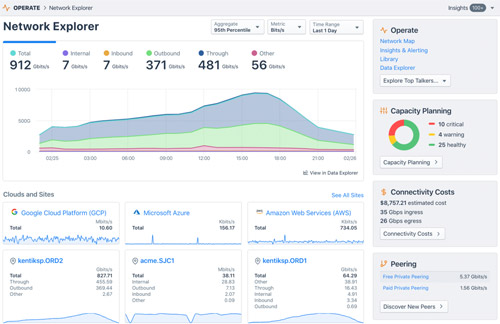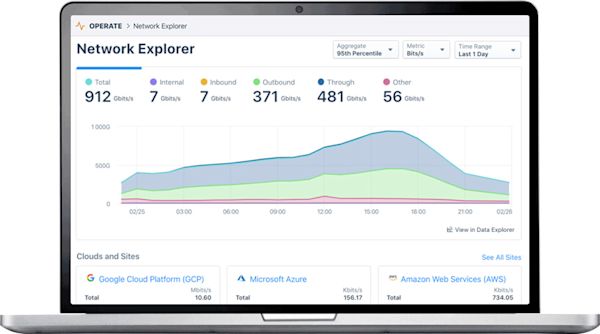
Summary
Today we announced an evolutionary leap forward for NetOps, solving for today’s biggest network challenge: effectively managing hybrid complexity and scale, at speed. In this post, Kentik CTO Jonah Kowall discusses what’s new with the latest release of the Kentik Platform.
Today we announced an evolutionary leap forward for network operations (NetOps), solving for today’s biggest network challenge: effectively managing hybrid complexity and scale, at speed.

From the very beginning, the Kentik Platform was designed to collect the most granular data from terabit-scale networks. The largest and most sophisticated network teams turn to Kentik to answer their most important questions around building the best networks to meet business demands. Their questions span topics from data about traffic (e.g. which applications are consumers using?), down to architectural decisions around peering and interconnection (e.g. how is content-provider data consumed by end-users?). Kentik, in short, allows networks to run as efficiently as possible for the most demanding service providers, SaaS companies, and digital enterprises.
The problems that Kentik solves are highly variable and sophisticated, such as understanding how traffic enters and exits networks, sliced by almost any facet of the data. Kentik’s success to date stems from delivering a truly scalable product that answers these questions in seconds. Our platform’s latest evolution complements our existing capabilities and enables NetOps to manage hybrid networks.
Historically, we’ve heard some users say it can be challenging to use, or learn from, network data if you do not know what you are looking for. That’s why Kentik introduced new capabilities that make it much easier to browse and understand your network resources without having intimate knowledge of the way the network is architected.
New features include Quick Views to provide instant access to common reports, and a Network Map of the logical and physical topology with step-by-step workflows to drive the most common network operations tasks. Initiating a discovery or fact-finding mission is now much faster and easier, while still providing the depth and power of our Data Explorer’s slicing-and-dicing capabilities.
The Kentik Platform includes real-time analytics, actionable insights, automation, and added integrations within four core modules:
-
Kentik Operate is designed for users responsible for day-to-day network operations. Within the Operate module is Network Explorer, which provides an overview of the network with organized, pre-built views of activity and utilization, a Network Map, and other ways to browse your network, including the devices, peers, and interesting patterns that Kentik finds in the traffic. To make NetOps teams more efficient, we’ve built workflows for troubleshooting and capacity management. These are some of the most basic (but not easy!) tasks required to operate today’s complex networks, which span data center, WAN, LAN, hybrid and multi-cloud infrastructures
-
Kentik Edge provides the ability to understand and optimize the edge of the network. Managing peering, interconnection, and the overall state of traffic crossing the network edge to and from other networks is critical for any organization doing business on the internet. We’ve built specific workflows and views to help with traffic engineering, which, up until today, often involved a manual effort and spreadsheets. With our traffic-cost capabilities, Kentik automates the management of monthly commitments and costs across multiple providers. Additionally, automation from Kentik helps with managing and advising on peering, by leveraging existing and new data sources (such as PeeringDB), to take the guesswork out of selecting interconnection. Finally, like any organization which interconnects, we are all concerned with the health of the internet as an open network. This is why Kentik has been a big proponent of RPKI to ensure the health and accuracy of BGP and routing to avoid hijacking. Kentik’s new capabilities automate the analysis of RPKI and traffic validity.
-
Kentik Protect is built to help secure your infrastructure and provide rapid understanding of network activity. The threat of DDoS attacks, BGP hijacking, and other malicious activities, coupled with today’s network diversity and complexity, makes it challenging to isolate outages and other denials-of-service against organizations. With newly improved DDoS workflows, and other security-related use cases, Kentik protects your critical network assets.
-
Kentik Service Provider delivers new ways to analyze traffic to and from CDNs, allowing you to understand cache placement and fill efficiency. Also, Kentik provides a deeper understanding of various types of over-the-top (OTT) applications and their delivery, most often through CDNs. Kentik Service Provider unlocks opportunities for businesses to produce new revenue opportunities via workflows to analyze customer usage and discover potential new business.
We also introduced Insights, which provides new methods to turn data into action. Powerful algorithms that understand normal traffic behavior and customizable policies surface relevant, actionable, and interesting events in real-time. This helps network operations to work more proactively to identify, troubleshoot, and resolve network issues.
The four modules work across every type of network from the LAN, WAN, and traditional data center to public cloud and cloud-native environments that produce VPC flow log information. Additionally, visibility into leading SD-WAN solutions has helped round out deeper application performance-based use cases. Aside from traffic and flow, Kentik also collects and analyzes device and interface-level metrics via SNMP and streaming telemetry to round out a complete set of visibility, further complementing our platform capabilities and filling the needs for network teams to overcome the challenges of managing hybrid infrastructures.
For more information on the launch, check out our technical update.
